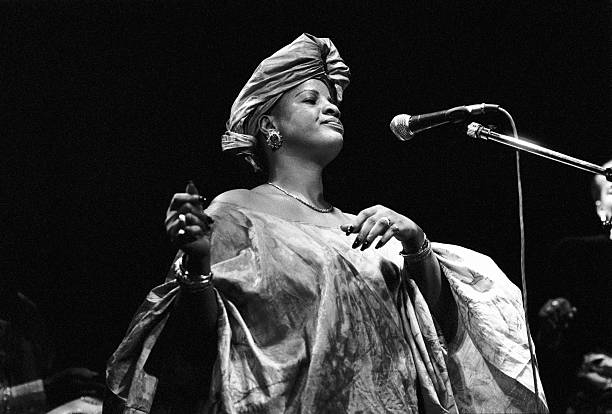If you watch television in Mali, you might almost think that music there was for women and by women only. The weekly music programme Top Étoiles features the public’s favourite artists, most of whom are women; the singers perform to backing tapes, so the male instrumentalists are nowhere to be seen, giving the impression that this is an allfemale affair. An interesting consequence of the predominance of the female voice is that many of their songs have concerned issues that affect women adversely, such as polygamy and arranged marriages.
A striking example is Kandia Kouyaté’s poignant “San Barana”, a heartfelt plea for co-wives to respect each other, based on her own personal experiences. Songs about the problems women face in marriage are very popular at wedding parties. If the new bride is marrying a man who already has other wives, she may find solace in such songs.
Many famous and legendary female singers from the early days of independence onwards, such as Kandia Kouyaté, Tata Bambo Kouyaté, Fanta Damba, Fanta Sacko, Ami Koïta, Naïny Diabaté and Bako Dagnon became famous primarily at wedding parties. Kandia (see box overleaf) is firmly grounded in the Maninka tradition of her home town of Kita, one of the great centres of jeli music, and the birthplace of many of Mali’s best musicians, including guitarist and bandleader Djelimady Tounkara, and balafonist Kélétigui Diabaté.
Malian men will often say that the style of Malian women singers is supposed to be “traditional”, but in practice, more and more are makingdaring inroads into popular and global styles, with varying degrees of success.
Ami Koïta is one of the great modernisers of the sumu or wedding music tradition. Born in Joliba, to the west of Bamako (as was Salif Keita), she was recruited into EIN. The group’s members were recruited from around the country during Mali’s Biennales festivals; they played for state occasions and festivals, and provided a showcase and training ground for many of Mali’s great female singers. Ami Koïta’s first solo recording was Wajan (1971). The title song was the direct inspiration for “Mandjou”, which propelled Salif Keita and Les Ambassadeurs to international fame in 1978. This is an example of how the dance bands drew on the art of women singers. Ami Koïta released a series of LPs and cassettes in the 1980s and early 1990s, with many songs dedicated to her main patron – a Senegalese businessman by the name of “Concorde” Gaye (so-called because he took so many Concorde planes), and who famously provided her with a new car every two years. Her music became increasingly contemporary-sounding, adding trumpet, saxophone, violin, synthesizer and drum machine to the usual jeli instrumentation. While some of her songs were in the Mande tradition, others were (controversially) influenced by Congolese soukous, zouk and even salsa, earning her the epithets jeli finesse (the sophisticated jeli) and jeli pachanga (from the Cuban 1960s dance rhythm called pachanga, which is how salsa is often referred to in Mali).
Tata Bambo Kouyaté is another of Mali’s most important and influential singers of the first postindependence generation. She rose to fame in the early 1960s with her song “Bambo” (hence her nickname), about the popular new law of 1962 protecting the rights of women in marriage. Her husband and musical partner Modibo Kouyaté was the first to introduce the electric guitar into the previously all-acoustic sumu ensemble in the late 1980s, along with pedal effects. This modernized and transformed the sound of wedding music, bringing it ever closer to popular contemporary dance styles and confirming the central role of women singers in Malian popular culture.
Less well known abroad is Naïny Diabaté. Born and raised in Bamako, she was one of the very few women to perform occasionally with the Rail Band back in the early 1980s while still in her late teens. The current star of the sumu scene is Babani Koné (born 1968). A charismatic singer, she first came to attention when she won the prize for best solo vocalist in Mali’s 1984 Biennale festival. Since 2000, her popularity has verged on cult celebrity status. No jelimuso has ever had such a huge following, making her one of the most wealthy of Mali’s female singers. When performing for a sumu, her style is quite traditional, but she has also recorded four albums aimed at the dancefloor, tinged with non-Malian rhythms like zouk, salsa and Congolese dance music. While her dance tracks, cluttered with synthesizers, animate local nightclubs, they do not sell well abroad – the gulf between how Bamako’s women sound at the sumu, and how they are represented on CD, with a few notable exceptions, is considerable. As a consequence, the central importance of the jelimuso in contemporary Malian music, and the raw energy, beauty and passion of the sumu and sandiya parties, remain largely unknown by World Music fans.


